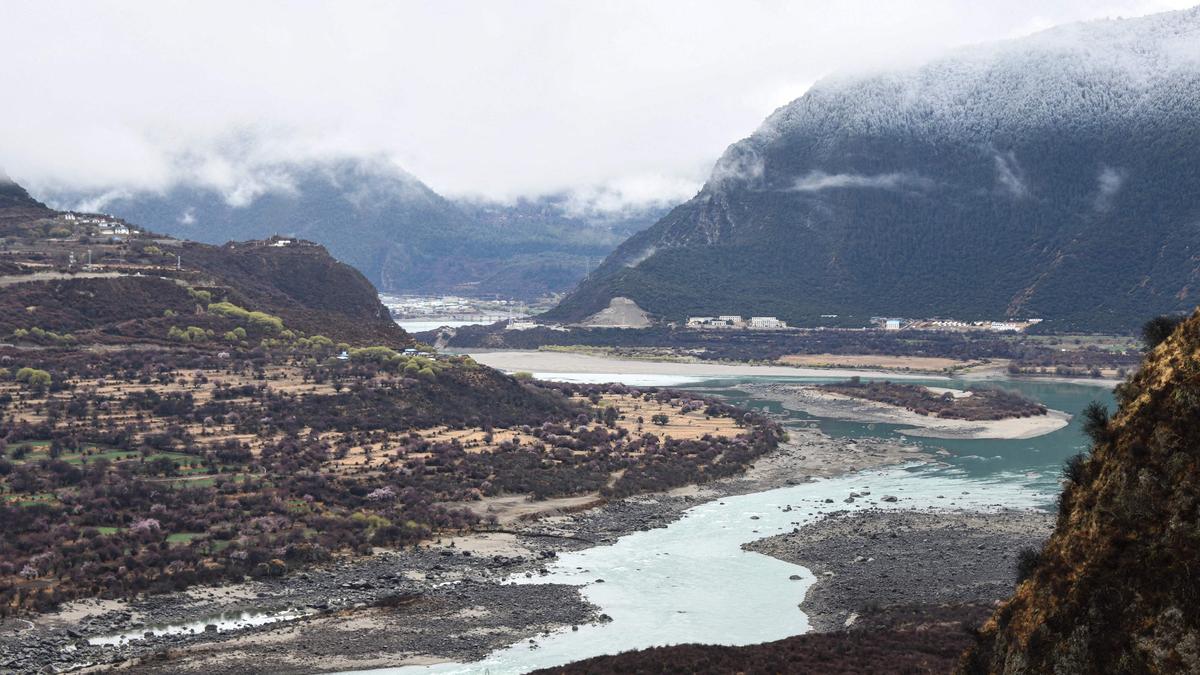A picture, of 2021, that shows the Yarlung Zangbo Grand Canyon in Nyingchi, China
| Photo Credit: AFP
The planned construction by China, of a massive hydroelectric dam on the lower section of the upper stream of the Yarlung Zangbo river in Tibet, has become a matter of concern for India due to its potential impact on the local environment and spillover, the flow of water downstream, and bilateral relations. Originating in Tibet, the Yarlung Zangbo is called the Brahmaputra after it reaches the Indian State of Assam where it meets its important tributaries. In India’s Arunachal Pradesh, it is called the Siang.
The Brahmaputra is a part of the everyday life of millions of people from India’s northeastern States and Bangladesh. China’s decision to plan a dam on the Yarlung Zangbo is a part of its broader strategy to transition from coal to renewable energy sources, particularly hydroelectric power. As outlined in its 14th Five-Year Plan (2021–2025), China aims to reduce its reliance on fossil fuels and achieve carbon neutrality by 2060. While this transition is commendable, the reliance on large-scale hydroelectric projects raises significant concerns. While the dam project aligns with China’s ambitious energy transition goals, its serious implications for India cannot be understated.
The legal dimensions
The construction of the dam raises critical legal issues under international water law. The United Nations Convention on the Law of the Non-Navigational Uses of International Watercourses (UN Watercourses Convention) 1997 emphasises the principles of equitable and reasonable utilisation, the obligation to prevent significant harm, and the duty to cooperate. These principles are essential in ensuring that shared water resources are managed sustainably and equitably.
However, China and India are not signatories to the UN Watercourses Convention. Nor do they adhere to a robust framework of domestic laws governing transboundary rivers. The official documents on water published by the Chinese government maintain that Beijing is a benevolent upper riparian that follows: first, the principle of international cooperation; second, the principle of people orientation; third, the principle of sharing rights and obligations, and fourth, the principle of equal emphasis on development and protection.
However, many of China’s lower riparian states accuse it for using water as a ‘powerful tool’. India, which is one of the lower riparian states, depends on rivers that originate in Tibet for one-third of its river water supply. Due to the increasing securitisation of water and the rise of assertive military nationalism, a number of Indian political analysts say that China poses a serious water threat to India, making it vulnerable to unilateral actions. India has regularly expressed its concerns about the projects on the transboundary rivers. The memoranda of understanding between India and China on the sharing of water data about the Sutlej and Brahmaputra rivers have expired now. With ties improving between the two countries, there is a possibility that the MoUs could also be renewed. There is an expert level mechanism (ELM) to deal with water-related matters that meets regularly. In the absence of a concrete agreement, the ELM’s role in managing water-related matters between India and China is significant.
Significant environmental concerns
The proposed dam is being constructed in one of the world’s most seismically active regions. The risk of earthquakes poses a significant threat to the stability of the structure, with the possibility of catastrophic consequences for both upstream and downstream areas. For instance, the earthquake in Tibet in January 2025 led to the death of more than 120 people while over 150 were injured. Additionally, the construction of such a massive dam disrupts river ecosystems, alters sediment flow, and threatens biodiversity in the river basin region. The potential environmental damage extends to the loss of habitats for aquatic and terrestrial species and increased riverbank erosion. Such a dam would also have an impact on Bangladesh which the Brahmaputra enters from India. However, Bangladesh has not expressed any serious concerns over the hydroproject. The main reason is the growing divide between Dhaka and New Delhi ever since the fall of the Sheikh Hasina government in August 2024 and the level of ties Bangladesh has with China.
A ‘water alliance’ and hurdles
But this is an issue that will not just affect Bangladesh. Water-related activities in Tibet will affect the other lower riparian South Asian states such as Nepal, Bhutan and Pakistan. To deal with the situation, it is better to have a water negotiation plan for the region.
However, given the political situation in South Asia, it is tough to imagine a water alliance between the countries receiving water from Tibet. An absence of an active regional organisation halts South Asia from developing a collective strategy to manage transboundary rivers and conduct negotiations with the upper riparian country. Bilateral ties between India and many of its neighbouring countries are not in good shape and see fluctuations frequently.
The water issue between India and China cannot be de-linked from their day-to-day political relations because of the influence of politics on water-related decisions.
The recent India-China diplomatic engagements raise hopes for renewing lapsed MoUs and improving trust through information-sharing on Tibet-origin rivers.
China has reiterated that the dam on the Yarlung Zangbo will not affect water flow to India. However, New Delhi has expressed its concerns. To clear any doubts or concerns that the lower riparian states might have, the ELM would be a better platform.
Amit Ranjan is Research Fellow, Institute of South Asian Studies (ISAS), National University of Singapore (NUS). Nabeela Siddiqui is Assistant Professor, Vinayaka Mission’s Law School (VMLS), Vinayaka Missions Research Foundation (VMRF)-Deemed University, Chennai
Published – February 14, 2025 12:08 am IST
